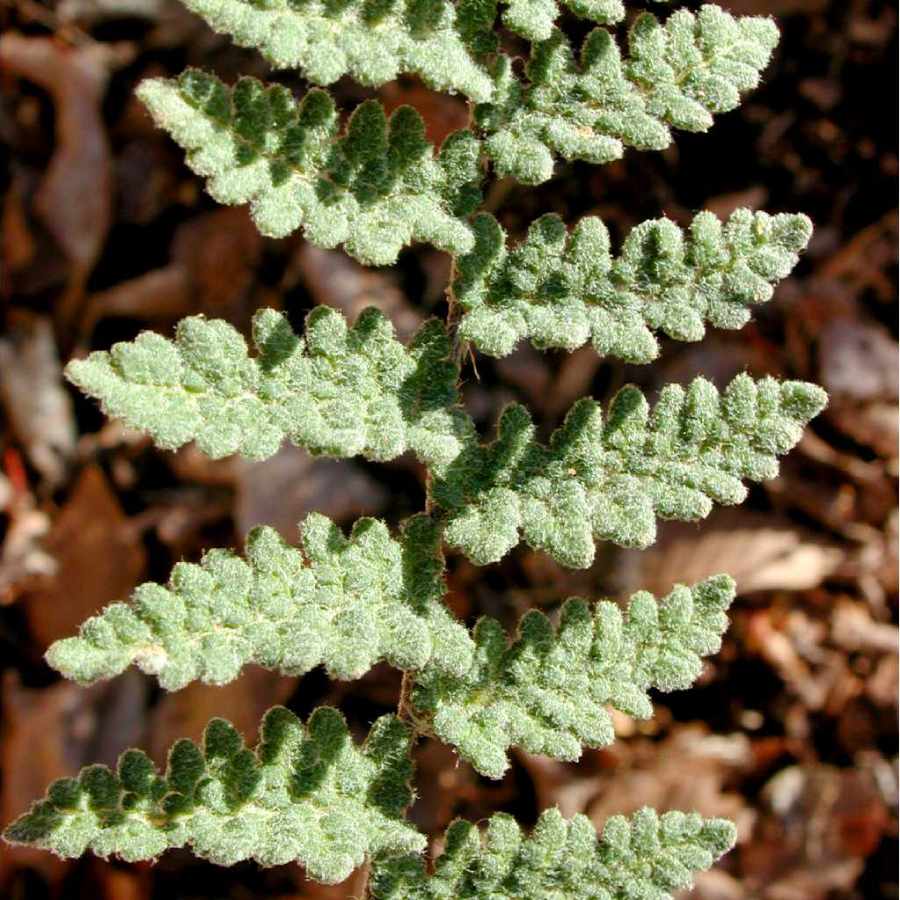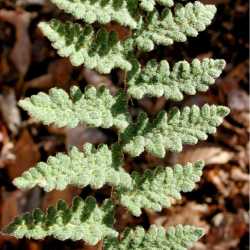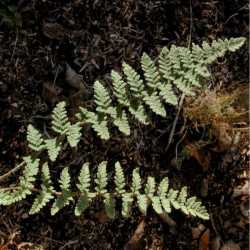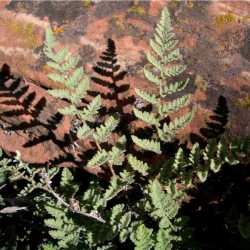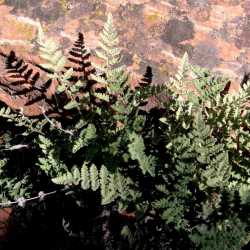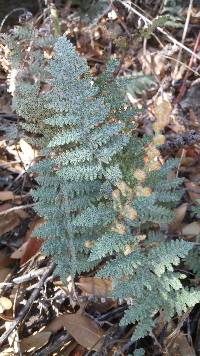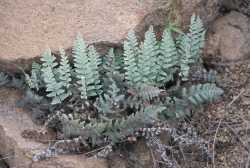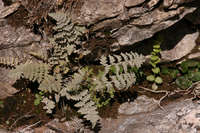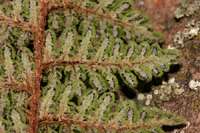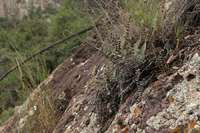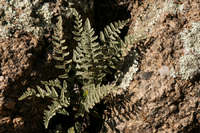Stems compact, 4--8 mm diam.; scales mostly bicolored, with broad, well-defined, dark, central stripe and narrow, light brown margins, linear-lanceolate, straight to slightly contorted, loosely appressed, persistent. Leaves clustered, 6--35 cm; vernation noncircinate. Petiole dark brown, rounded adaxially. Blade oblong-lanceolate, 3--4-pinnate at base, 1.5--5 cm wide; rachis rounded adaxially, with scattered linear-lanceolate scales and monomorphic pubescence. Pinnae not articulate, dark color of stalk continuing into pinna base, basal pair not conspicuously larger than adjacent pair, usually equilateral, appearing tomentose to glabrescent adaxially. Costae green adaxially for most of length; abaxial scales multiseriate, lanceolate to linear, truncate or subcordate at base, without overlapping basal lobes, conspicuous, the largest 0.4--0.7 mm wide, loosely imbricate, not concealing ultimate segments, erose-dentate, rarely with 1--2 cilia at base on a few scales. Ultimate segments oval to round, beadlike, the largest 1--3 mm, abaxially densely tomentose, adaxially pubescent with fine, unbranched hairs or glabrescent. False indusia marginal to obscurely inframarginal, somewhat differentiated, 0.05--0.25 mm wide. Sori ± continuous around segment margins. Sporangia containing 32 spores. n = 2 n = 90, 120, apogamous.
Sporulating summer--fall. Rocky slopes and ledges, found on a variety of substrates including limestone and granite; 300--3000 m; Ariz., Ark., Colo., N.Mex., Okla., Tex., Utah, Va., W.Va.; Mexico; Central America in Costa Rica.
As here circumscribed, Cheilanthes eatonii is a variable species comprising apogamous triploid and tetraploid cytotypes of unknown parentage. It includes plants previously identified as C . castanea and C . pinkavii (ined.). Type specimens of C . eatonii and C . castanea are quite distinct morphologically, but most plants here included within C. eatonii are intermediate between these two extremes (T. Reeves 1979). Because there is no clear morphologic break, C . castanea is placed here in synonymy under C . eatonii pending further study. Reports of hybridization between C . eatonii and C . villosa (D. B. Lellinger 1985) are based on specimens from western Texas and southern New Mexico that appear to be intermediate between these taxa in several characters. T. Reeves (1979) applied the name C . pinkavii to these specimens; that name has never been validly published. Formal recognition of this taxon is deferred pending completion of a biosystematic study of the C . eatonii complex as a whole.
General: Rhizomatous with compact stems, 4-8 mm in diameter, scales mostly bicolored with broad, well-defined, dark, central stripe and narrow, light brown margins, linear-lanceolate, straight to slightly contorted, loosely appressed, persistent.
Leaves: Clustered, 6-35 cm, noncircinate vernation; petiole dark brown, rounded above, blade oblong-lanceolate, 3-4 pinnate at base, 1.5-5 cm wide; with scattered linear-lanceolate scales and monomorphic pubescence; pinnae not articulate, dark color of stalk continuing into pinna base, basal pair not conspicuously larger than adjacent pair, usually equilateral, appearing tomentose above; costae green above for most of length, scales below multiseriate, lanceolate to linear, truncate or subcordate at base, without overlapping basal lobes; erose-dentate; ultimate segments oval or round, beadlike, largest 1-3 mm, densely tomentose below.
Sporangia: False indusia marginal to obscurely inframarginal, somewhat differentiated, 0.05-0.25 mm wide; sori continuous around segment margins.
Ecology: Found on rocky slopes and ledges, on a variety of substrates including limestone and granite from 1,500-10,000 ft (457-3048 m); sporulating summer-fall.
Notes: Often confused with C. tomentosa, differs in having scales on the rachis and abaxial surface of the pinnae more or less ovate rather than narrow and hairlike. Some collections in the eastern part of the range have been glabrous, which has been designated as forma castanea. Plants in the region are not generally this form.
Etymology: Cheilanthes is from Greek cheilos for lip and anthos for flower, while eatonii is named for the American botanist Daniel Cady Eaton (1834-1895).
Sources: FNA 1993
Common Name: Eaton's lipfern
General: Rhizomatous with compact stems, 4-8 mm in diameter, scales mostly bicolored with broad, well-defined, dark, central stripe and narrow, light brown margins, linear-lanceolate, straight to slightly contorted, loosely appressed, persistent.
Leaves: Clustered, 6-35 cm, noncircinate vernation; petiole dark brown, rounded above, blade oblong-lanceolate, 3-4 pinnate at base, 1.5-5 cm wide; with scattered linear-lanceolate scales and monomorphic pubescence; pinnae not articulate, dark color of stalk continuing into pinna base, basal pair not conspicuously larger than adjacent pair, usually equilateral, appearing tomentose above; costae green above for most of length, scales below multiseriate, lanceolate to linear, truncate or subcordate at base, without overlapping basal lobes; erose-dentate; ultimate segments oval or round, beadlike, largest 1-3 mm, densely tomentose below.
Sporangia: False indusia marginal to obscurely inframarginal, somewhat differentiated, 0.05-0.25 mm wide; sori continuous around segment margins.
Ecology: Found on rocky slopes and ledges, on a variety of substrates including limestone and granite from 1,500-10,000 ft (457-3048 m); sporulating summer-fall.
Notes: Distinguished by appearing gray-whitish green due to the dense, whitish, tanged hairs (tomentose) (the amount of hairs is variable); on the bottom surface, the scales tend to not obscure the tomentum on the terminal pinnules (unlike C. lindheimeri) and are not ciliate; the bicolored stem scales with a dark central stripe also help.
Ethnobotany: Unknown
Etymology: Cheilanthes is from Greek cheilos for lip and anthos for flower, while eatonii is named for the American botanist Daniel Cady Eaton (1834-1895).
Synonyms: Cheilanthes castanea, C. eatonii var. castenea
Editor: SBuckley 2010, FSCoburn 2015
Much like no. 4 [Cheilanthes tomentosa Link], but more scaly, the scales lanceolate, mostly 0.2-1 mm wide, borne on the rachis and costae (especially the lower side) and to some extent on the lower surface of the pinnules, where intermingled with the rusty tomentum; terminal segment of the pinnae and pinnules more elongate, typically 2-3 times as long as wide; spores 32; 2n=87 (triploid). Cliff-crevices and talus-slopes; mts. of Va. and W.Va.; Okla. and Tex. to Utah and Ariz. (C. castanea, the phase with the upper lf-surface thinly hairy to glabrate, the only phase in our range)
Gleason, Henry A. & Cronquist, Arthur J. 1991. Manual of vascular plants of northeastern United States and adjacent Canada. lxxv + 910 pp.
©The New York Botanical Garden. All rights reserved. Used by permission.


